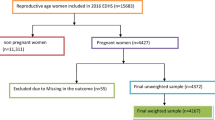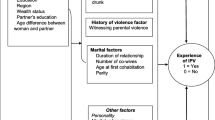Abstract
Based on the results of previous investigations, this study seeks for individual, relationship and community characteristics among women living with their partner associated with intimate partner violence [IPV] victimization. The sample of 19,131 women was taken from the 2016 Peru Demographic and Health Survey. A binomial logistic regression model showed among the most significant risk factors: heavy drinking by the woman’s partner (OR = 8.655, p < .001), having witnessed parental domestic violence (OR = 1.496, p < .001) and having experienced physical punishment during childhood (OR = 1.306, p < .001). Other factors related to higher odds of IPV at the individual level include employment and low educational attainment. Relationship risk factors comprise, 25 to 29 years of relationship duration, living in cohabitation, previous unions and low socioeconomic status. At the community level, living in an urban residence increases the likelihood of abuse. These findings highlight the need to include these factors, in the IPV prevention strategies.
Similar content being viewed by others
References
Abramsky, T., Watts, C. H., Garcia-Moreno, C., Devries, K., Kiss, L., Ellsberg, M., et al. (2011). What factors are associated with recent intimate partner violence? Findings from the WHO multi-country study on women's health and domestic violence. BMC Public Health, 11(1), 109–125. doi:10.1186/1471-2458-11-109.
Bandura, A. (1986). The social learning perspective: Mechanisms of aggression. In H. Toch (Ed.), Psychology of crime and criminal justice (pp. 198–236). Prospect Heights: Waveland Press.
Bardales, O. (2012). Estado de las Investigaciones sobre Violencia Familiar y Sexual en el Perú 2006–2010. Lima: Sagitario Editores e Impresores.
Brown, S., & Bulanda, J. R. (2008). Relationship Violence in Young Adulthood: A Comparison of Daters, Cohabitors, and Marrieds. Social Science Research, 37, 73–87. doi:10.1016/j.ssresearch.2007.06.002.
Campos Moreira, T., Ferigolo, M., Fernandes, S., Barros, X., Mazoni, C., Noto, A., et al. (2011). Alcohol and Domestic Violence: A Cross-Over Study in Residences of Individuals in Brazil. Journal of Family Violence, 26(6), 465–471. doi:10.1007/s10896-011-9381-5.
Castro, R., & Casique, I. (2009). Violencia de pareja contra las mujeres en México: una comparación entre encuestas recientes. In CEPAL (Ed.), Notas de población Vol. 35 N° 87 (pp. 35–61). CEPAL: Santiago de Chile http://repositorio.cepal.org/handle/11362/37695.
Castro, R., & Rivera, C. (2015). Mapa de la violencia contra la mujer: La importancia de la familia. Revista de Investigacion (Arequipa), 6, 101–125. http://ucsp.edu.pe/investigacion/wp-content/uploads/2016/03/5.-Mapa-de-la-violencia-contra-la-mujer.pdf. Accessed 23 Mar 2017.
Chan, K. L. (2009). Sexual violence against women and children in Chinese societies. Trauma Violence & Abuse, 10(1), 69–85. doi:10.1177/1524838008327260.
Collins, J. J., & Messerschmidt, P. M. (1993). Epidemiology of alcohol-related violence. (Cover story). Alcohol Health & Research World, 17(2), 93–100.
Dador, J. (2011). Violencia de género: aportes para el Gobierno Peruano 2011–2016. Lima: Ediciones Nova Print.
Day, T., McKenna, K., & Bowlus, A. (2005). The Economic Costs of Violence against Women: An Evaluation of the Literature. London: United Nations.
Díaz, R., & Miranda, J. (2010). Aproximación del Costo Económico y Determinantes de la Violencia Doméstica en el Perú. In CIES (Ed.), Economía y Sociedad (Vol. 75, pp. 56–62). Lima: CIES http://old.cies.org.pe/files/documents/EyS/75/08-DIAZ%20MIRANDA.pdf.
Dutton, D. G., & Strachan, C. E. (1987). Motivational needs for power and spouse-specific assertiveness in assaultive and nonassaultive men. Violence and Victims, 2(3), 145–156.
Ellsberg, M., Heise, L., Peña, R., Agurto, S., & Winkvist, A. (2001). Researching domestic violence against women: Methodological and ethical considerations. Studies in Family Planning, 32(1), 1–16. doi:10.1111/j.1728-4465.2001.00001.x.
Eng, S., Szmodis, W., & Grace, K. (2017). Cambodian Remarried Women Are at Risk for Domestic Violence. Journal of Interpersonal Violence. doi:10.1177/0886260517691520.
Fenton, B., & Rathus, J. (2010). Men’s Self-Reported Descriptions and Precipitants of Domestic Violence Perpetration as Reported in Intake Evaluations. Journal of Family Violence, 25(2), 149–158. doi:10.1007/s10896-009-9278-8.
Field, C. A., Caetano, R., & Nelson, S. (2004). Alcohol and Violence Related Cognitive Risk Factors Associated with the Perpetration of Intimate partner Violence. Journal of Family Violence, 19(4), 249–253. doi:10.1023/B:JOFV.0000032635.42145.66.
Flake, D. F. (2005). Individual, family and community risk markers for domestic violence in Peru. Violence Against Women, 11(3), 353–373. doi:10.1177/1077801204272129.
Flake, D., & Forste, R. (2006). Fighting Families: Family Characteristics Associated with Domestic Violence in Five Latin American Countries. Journal of Family Violence, 21(1), 19–29. doi:10.1007/s10896-005-9002-2.
Garcia-Moreno, C., Jansen, H. A., Ellsberg, M., Heise, L., & Watts, C. H. (2006). Prevalence of intimate partner violence: findings from the WHO multi-country study on women's health and domestic violence. Lancet, 368(9543), 1260–1269. doi:10.1016/S0140-6736(06)69523-8.
Gonzales, E., & Gavilano, P. (1998). Pobreza y Violencia Doméstica contra la Mujer en Lima Metropolitana. Lima: IEP http://lanic.utexas.edu/project/laoap/iep/ddt094.pdf.
Guillen-Royo, M. (2008). Consumption and Subjective Wellbeing: Exploring Basic Needs, Social Comparison, Social Integration and Hedonism in Peru. Social Indicators Research, 89(3), 535–555. doi:10.1007/s11205-008-9248-1.
Heaton, T., & Forste, R. (2008). Domestic Violence, Couple Interaction and Children’s Health in Latin America. Journal of Family Violence, 23(3), 183–193. doi:10.1007/s10896-007-9142-7.
Heise, L. (1998). Violence against Women: An Integrated, ecological framework. Violence Against Women, 4(3), 262–290. doi:10.1177/1077801298004003002.
IBM Corp. (2011). IBM SPSS Statistics for Windows, Version 20.0. Armonk: IBM Corp.
INMUJERES (2006). Violencia Sexual contra las Mujeres en el Seno de la Pareja Conviviente. http://cedoc.inmujeres.gob.mx/documentos_download/100790.pdf
Instituto de Estudios del Capital Social [INCAS] (2007). Una Aportación al Estudio de las Causas de Feminicidio en Pareja. http://www.unav.edu/matrimonioyfamilia/observatorio/documentos/Abat-Oliba_ Feminicidio-2007.pdf
Instituto Nacional de Estadística e Informática [INEI]. (2001). Perú Encuesta Demográfica y de Salud Familiar – ENDES 2000: nacional y departamental. Lima: INEI.
Instituto Nacional de Estadística e Informática [INEI]. (2005). Encuesta Demográfica y de Salud Familiar – Manual de la Entrevistadora. Lima: INEI http://proyectos.inei.gob.pe/endes/recursos/endes2004-05_manual.pdf.
Instituto Nacional de Estadística e Informática [INEI]. (2013). Perú Encuesta Demográfica y de Salud Familiar – ENDES 2012: nacional y departamental. Lima: INEI.
Instituto Nacional de Estadística e Informática [INEI]. (2016a). Encuesta demográfica y de salud familiar - ENDES 2015. Lima: INEI.
Instituto Nacional de Estadística e Informática [INEI]. (2016b). Encuesta demográfica y de salud familiar - ENDES 2016. (database). Lima: INEI http://iinei.inei.gob.pe/microdatos/.
Jeyaseelan, L., Sadowski, L. S., Kumar, S., Hassan, F., Ramiro, L., & Vizcarra, B. (2004). World studies of abuse in the family environment - risk factors for physical intimate partner violence. Injury Control & Safety Promotion, 11(2), 117–124. doi:10.1080/15660970412331292342.
Johnson, K. B., & Das, M. B. (2009). Spousal violence in Bangladesh as reported by men: prevalence and risk factors. Journal of Interpersonal Violence, 24(6), 977–995. doi:10.1177/0886260508319368.
Kalmuss, D., & Seltzer, J. A. (1986). Continuity of Marital Behavior in Remarriage: The Case of Spouse Abuse. Journal of Marriage & Family, 48(1), 113–120. doi:10.2307/352234.
Kenney, C. T., & McLanahan, S. S. (2006). Why are cohabitating relationships more violent than marriages? Demography, 43(1), 127–140.
Kyriacou, D. N., Anglin, D., Taliaferro, E., Stone, S., Tubb, T., Linden, J. A., et al. (1999). Risk Factors for Injury to Women from Domestic Violence. New England Journal of Medicine, 341(25), 1892–1898. doi:10.1056/NEJM199912163412505.
Lazo, D. (2015). Violencia conyugal en el Perú: una aproximación econométrica. Unpublished raw data.
Lee, R., Walters, M., Hall, J., & Basile, K. (2013). Behavioral and Attitudinal Factors Differentiating Male Intimate Partner Violence Perpetrators With and Without a History of Childhood Family Violence. Journal of Family Violence, 28(1), 85–94. doi:10.1007/s10896-012-9475-8.
Matos, S., & Cordano, D. (2006). Violencia Conyugal de Tipo Físico en el Perú. Distribución Regional, Caracterización de Víctimas y Agresores, Factores Asociados y Consecuencias de un problema de salud pública. Lima: INEI https://www.inei.gob.pe/media/MenuRecursivo/publicaciones_digitales/Est/Lib0687/Libro.pdf.
Matos, S., & Sulmont, D. (2009). Modelos multivariados para la violencia conyugal, sus consecuencias y la solicitud de ayuda. Lima: INEI https://www.inei.gob.pe/media/MenuRecursivo/publicaciones_digitales/Est/Lib0899/Libro.pdf.
Maxwell, C., & Stone, R. (2010). The Nexus between Economics and Family Violence: The Expected Impact of Recent Economic Declines on the Rates and Patterns of Intimate, Child and Elder Abuse. Workshop on Home Foreclosure and Crime, 1, 1–46 https://www.ncjrs.gov/pdffiles1/nij/grants/229913.pdf.
Meekers, D., Pallin, S. C., & Hutchinson, P. (2013). Prevalence and correlates of physical, psychological, and sexual intimate partner violence in Bolivia. Global Public Health, 8(5), 588–606. doi:10.1080/17441692.2013.776093.
Mendoza, J., & Roca R. (2011). Determinantes de la violencia física conyugal a nivel de departamentos peruanos. Horizonte Económico, 1, 37–50. https://issuu.com/facultadcienciaseconomicas/docs/articulo4. Retrieved 25 Apr 2017.
Miljanovich, M., Nolberto, V., Martina, M., Huerta, R., Torres, S., & Camones, F. (2010). Perú: mapa de violencia familiar, a nivel departamental, según la ENDES 2007-2008: Características e implicancias. Revista de Investigación UNMSM, 13(2), 191–206.
Ministerio de la Mujer y Desarrollo Social (2009). Plan Nacional Contra la Violencia hacia la Mujer 2009–2015. http://www.unfpa.org.pe/Legislacion/PDF/20090326-MIMDES-Plan-Nacional-Contra -la-Violencia-Hacia-la-Mujer_2009-2015.pdf
Morgan, P. (2000). Marriage-Lite: The Rise of Cohabitation and its Consequences. Gran Bretaña: Cromwell Press.
Morrison, A., & Orlando, M. (2004). The costs and impacts of gender-based violence in developing countries: Methodological considerations and new evidence. Washington, DC: World Bank.
Ochoa, S. (2002). Factores asociados a la presencia de violencia hacia la mujer. Lima: Instituto Nacional de Estadística e Informática INEI http://www.inei.gob.pe/biblioineipub/bancopub/Est/Lib0560/Libro.pdf.
Organización Mundial de la Salud [OMS]. (2005). Estudio Multipaís de la OMS sobre salud de la mujer y violencia doméstica: primeros resultados sobre prevalencia, eventos relativos a la salud y respuestas de las mujeres a dicha violencia: resumen del informe. Ginebra: Organización Mundial de la Salud.
Pliego, F. (2012). Familias y Bienestar en Sociedades Democráticas. El Debate Cultural del Siglo XXI. México: Porrua.
Pollak, R. (2004). An Intergenerational Model of Domestic Violence. Journal of Population Economics, 17(2), 311–329. doi:10.1007/s00148-003-0177-7.
Rivera, C., & Castro, R. (2016). Construcción de un Índice de intensidad de violencia contra la mujer. Manuscript submitted for publication.
Rodríguez, M. (2014). Familia hoy: amor conyugal. Arequipa: Fondo editorial UCSP.
Salgado, J. (2009). Justicias y desprotección a mujeres indígenas contra la violencia. Posibilidades de interculturalidad. Revista Electrónica Aportes Andinos, 25, 1–14. http://portal.uasb.edu.ec/padh_contenido.php?pagpath=1&swpath=infb&cd_centro=5&ug=ig&cd=2440. Retrieved 4 May 2017.
Schewe, P., Riger, S., Howard, A., Staggs, S., & Mason, G. (2006). Factors Associated with Domestic Violence and Sexual Assault Victimization. Journal of Family Violence, 21(7), 469–475. doi:10.1007/s10896-006-9042-2.
Seinfeld, J., & Galarza, F. (2014). Understanding Underage Drinking in Peru: Determinants of Its Frequency and Intensity. Economia, 37(73), 47–74 http://revistas.pucp.edu.pe/index.php/economia/article/view/10084/10521.
Shackelford, T. (2001). Cohabitation, Marriage and Murder: Woman Killing by Male Romantic Partners. Aggressive Behavior, 27, 284–281. doi:10.1002/ab.1011.
Shaughnessy, J., Zechmeister, E., & Zechmeister, J. (2012). Research Methods in Psychology (9th ed.). New York: McGraw-Hill.
Slabbert, I. (2017). Domestic Violence and Poverty Some Women’s Experiences. Social Work Practice, 27(2), 223–230.
Tenkorang, E., Owusu, A., Yeboah, E., & Bannerman, R. (2013). Factors Influencing Domestic and Marital Violence against Women in Ghana. Journal of Family Violence, 28(8), 771–781. doi:10.1007/s10896-013-9543-8.
United Nations (1993). Declaration on the elimination of violence against women. (A/res/48/104). http://www.un.org/documents/ga/res/48/a48r104.htm
World Health Organization. (2010). Preventing intimate partner and sexual violence against women: taking action and generating evidence. Geneva: World Health Organization.
Author information
Authors and Affiliations
Corresponding author
Rights and permissions
About this article
Cite this article
Castro, R.J., Cerellino, L.P. & Rivera, R. Risk Factors of Violence against Women in Peru. J Fam Viol 32, 807–815 (2017). https://doi.org/10.1007/s10896-017-9929-0
Published:
Issue Date:
DOI: https://doi.org/10.1007/s10896-017-9929-0




